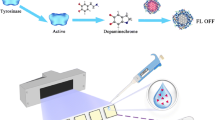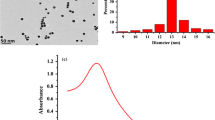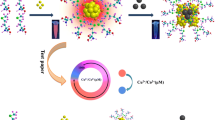Abstract
Pesticide contamination of drinking water is of high concern due to their hazardous effects on ecosystems. Several detection methods are available which are associated with many drawbacks, e.g. slow response time and laborious procedural techniques. This limits their practicability. Therefore, there is a dire need to develop quick, simpler but equally sensitive and practical methods for pesticide detection. Herein, we report a highly sensitive assay using fluorescent AuNCs for the detection of a pesticide i.e., 2-methyl-4-chlorophenoxyacetic acid (MCPA). For this purpose, three different fluorescent Au nanoclusters stabilized by histidine (His-AuNCs), lysozyme (Lys-AuNCs) and RNase (RNase-AuNCs) were systematically studied as optical probes for the detection of MCPA using a turn-on assay. The fluorescence of these AuNCs was initially quenched with Cu2+ ions followed by the quantitative recovery of their fluorescent signals in the presence of MCPA. The sensitivity and selectivity of these clusters for MCPA were in a linear dynamic range, i.e., 110–180 nM, 100–170 nM and 90–160 nM in case of His-AuNCs, Lys-AuNCs and RNase-AuNCs, respectively. Also, the aforesaid clusters were having a different limit of detection (LOD) by each type, i.e., highest by His-AuNCs (21.87), intermediate by Lys-AuNCs (12.97) and lowest by RNase-AuNCs (9.26 nM). Hence, the RNase-AuNCs are found to be the most sensitive, whereas His-AuNCs are least sensitive for the detection of MCPA. These findings offer a rapid, sensitive and selective assay for MCPA detection and have potential implications for the on-site, real-time monitoring of noxious pollutants.






Similar content being viewed by others
Data availability
All the data and material included in the manuscript is available.
References
Abtahi S et al (2018) Size, shape, and surface coating impacts on the colloidal stability and aggregation rate of gold nanoparticles in aquatic matrices. In: Implications of shape factors on fate, uptake, and nanotoxicity of gold nanomaterials, p 118
Anirudhan TS, Alexander S (2015) Design and fabrication of molecularly imprinted polymer-based potentiometric sensor from the surface modified multiwalled carbon nanotube for the determination of lindane (γ-hexachlorocyclohexane), an organochlorine pesticide. Biosens Bioelectron 64:586–593
Azab HA, Khairy GM, Kamel RM (2015) Time-resolved fluorescence sensing of pesticides chlorpyrifos, crotoxyphos and endosulfan by the luminescent Eu(III)-8-allyl-3-carboxycoumarin probe. Spectrochim Acta Part A Mol Biomol Spectrosc 148:114–124
Carvalho FP (2017) Pesticides, environment, and food safety. Food Energy Secur 6(2):48–60
Chen J, Chen W-YYJ et al (2010) Functional gold nanoclusters as antimicrobial agents for antibiotic-resistant bacteria. Nanomedicine 5:755–764
Chen Z et al (2012) Protein-templated gold nanoclusters based sensor for off–on detection of ciprofloxacin with a high selectivity. Talanta 94(6):240–245
Damalas CA, Eleftherohorinos IG (2011) Pesticide exposure, safety issues, and risk assessment indicators. Int J Environ Res Public Health 8(5):1402–1419
Davies JED, Jabeen N (2002) The adsorption of herbicides and pesticides on clay minerals and soils. Part 1. Isoproturon. J Inclus Phenom Macrocycl C 43(3–4):329–336
Deng H-H et al (2016) Colorimetric detection of urea, urease, and urease inhibitor based on the peroxidase-like activity of gold nanoparticles. Anal Chim Acta 915:74–80
Dias AN et al (2015) Use of green coating (cork) in solid-phase microextraction for the determination of organochlorine pesticides in water by gas chromatography-electron captu. Talanta 134:409–414
Discenza D (2016) Supporting parents with mental health support in the NICU. NN 35(1):42–44
DiScenza DJ et al (2017) Detection of organochlorine pesticides in contaminated marine environments via cyclodextrin-promoted fluorescence modulation. ACS Omega 2(12):8591–8599
Dobson CM, Winter NS (2014) The identification of amino acids by interpretation of titration curves: an undergraduate experiment for biochemistry. World J Chem Educ 2(4):59–61
Durgadas CV, Sharma CP, Sreenivasan K (2011) Fluorescent gold clusters as nanosensors for copper ions in live cells. Analyst 136(5):933–940
Eto M (2018) Organophosphorus pesticides. CRC, Oxford
Gao L, Ju L, Cui H (2017) Chemiluminescent and fluorescent dual-signal graphene quantum dots and their application in pesticide sensing arrays. J Mater Chem C 5(31):7753–7758
Gimeno O et al (2014) Ozonation of 4-chloro-2-methylphenoxyacetic acid (MCPA) in an activated sludge system. J Chem Technol Biotechnol 89(8):1219–1227
Goswami N et al (2016) Luminescent metal nanoclusters with aggregation-induced emission. J Phys Chem Lett 7(6):962–975
Heys KA et al (2017) Levels of organochlorine pesticides are associated with amyloid aggregation in apex avian brains. Environ Sci Technol 51(15):8672–8681
Ibrahim IA, Abbas AM, Darwish HM (2017) Fluorescence sensing of dichlorvos pesticide by the luminescent Tb (III)-3-ally-salicylohydrazide probe. Luminescence 32(8):1541–1546
Jayaraj R, Megha P, Sreedev P (2016) Organochlorine pesticides, their toxic effects on living organisms and their fate in the environment. Interdiscip Toxicol 9(3–4):90–100
Jia M et al (2017) A molecular imprinting fluorescence sensor based on quantum dots and a mesoporous structure for selective and sensitive detection of 2, 4-dichlorophenoxyacetic acid. Sens Actuators B Chem 1(252):934–943
Jiang D et al (2016) Fluorescent switch sensor for detection of anticancer drug and ctDNA based on the glutathione stabilized gold nanoclusters. Sens Chem 232:276–282
K’Owino IO, Masika K, Okello VA (2018) Kinetics of degradation of metribuzin in aqueous solution using zero valent iron nanoparticles. Al-Nahrain J Sci 21(2):1–9
Kah M et al (2007) Behaviour of ionisable pesticides in soils. PhD Thesis
Kalwar A, Jamali NH et al (2015) Catalytic degradation of imidacloprid using L-serine capped nickel nanoparticles. Mater Express. 5(2 SRC-BaiduScholar):121–128
Katagi T (2010) Bioconcentration, bioaccumulation, and metabolism of pesticides in aquatic organisms, reviews of environmental contamination and toxicology, Springer. 2010 SRC—BaiduScholar, pp 1–132
Koczera P et al (2016) The ribonuclease a superfamily in humans: canonical RNases as the buttress of innate immunity. Int J Mol Sci 17(8):1278
Koirala P, Banuelos JL (2018) The inverse and direct Hofmeister series of Hen egg lysozyme at pH below isoelectric point (pI) as seen by SAXS. Bull Am Phys Soc 106(36):15249–15253
Kong Y et al (2013) Near-infrared fluorescent ribonuclease-A-encapsulated gold nanoclusters: preparation, characterization, cancer targeting and imaging. Nanoscale 5(3):1009–1017
Kumar P, Kim KH, Deep A (2015) Recent advancements in sensing techniques based on functional materials for organophosphate pesticides. Biosens Bioelectron 70:469–481
Lai X et al (2017) Coordination-induced decomposition of luminescent gold nanoparticles: sensitive detection of H2O and glucose. Anal Bioanal Chem 409(6):1635–1641
Le Guével X et al (2011) NIR-emitting fluorescent gold nanoclusters doped in silica nanoparticles. J Mater Chem 21(9):2974–2981
Li J, Zhu K, Xu JJ (2014) Fluorescent metal nanoclusters: from synthesis to applications. Tr Anal Chem. 58(SRC-BaiduScholar):90–98
Li X et al (2018) Development and application of a novel fluorescent nanosensor based on FeSe quantum dots embedded silica molecularly imprinted polymer for the rapid optosensing of cyfluthrin. Biosens Bioelectron 99:268–273
Lin C-AJ et al (2009) Synthesis, characterization, and bioconjugation of fluorescent gold nanoclusters toward biological labeling applications. ACS Nano 3(2):395–401
Lu H, Quan S, Xu S (2017) Highly sensitive ratiometric fluorescent sensor for trinitrotoluene based on the inner filter effect between gold nanoparticles and fluorescent nanoparticles. J Agric Food Chem 65(44):9807–9814
Luo J et al (2016) Fluorescent turn-on determination of the activity of peptidases using peptide templated gold nanoclusters. Microchim Acta 183(2):605–610
Markechová AD, Tomková M, Sádecká J (2013) Fluorescence excitation-emission matrix spectroscopy and parallel factor analysis in drinking water treatment. Pol J Environ Stud 22(5):1289–1295
Oh E et al (2016) Energy transfer sensitization of luminescent gold nanoclusters: more than just the classical förster mechanism. Sci Rep 6:35538
Ramesh BS et al (2016) Detection of cell surface calreticulin as a potential cancer biomarker using near-infrared emitting gold nanoclusters. Nanotechnology 27(28):285101
Shamsipur M et al (2015) Novel blue-emitting gold nanoclusters confined in human hemoglobin, and their use as fluorescent probes for copper (II) and histidine. Microchim Acta 182(5–6):1131–1141
Skiba E, Kobyłecka J, Wolf WM (2017) Influence of 2,4-D and MCPA herbicides on uptake and translocation of heavy metals in wheat (Triticumaestivum L.). Environ Pollut (Barking, Essex: 1987) 220(Pt B):882–890
Taghavi S et al (2016) Microbial compositions for use in combination with soil insecticides for benefiting plant growth. United States patent application US 14/870, p 349
Talbert W et al (2016) Turn-on detection of pesticides via reversible fluorescence enhancement of conjugated polymer nanoparticles and thin films. N J Chem 40:7273–7277
Tao Y et al (2015) Metal nanoclusters: novel probes for diagnostic and therapeutic applications. Chem Soc Rev 44(23):8636–8663
Tsoi KM et al (2013) Are quantum dots toxic? Exploring the discrepancy between cell culture and animal studies. Acc Chem Res 46(3):662–671
Tu L, Xu J et al (2015) Near-infrared fluorescent turn-on detection of paraquat using an assembly of squaraine and surfactants. Sens Chem 215(SRC BaiduScholar):382–387
Walia S, Acharya A (2014) Fluorescent cadmium sulfide nanoparticles for selective and sensitive detection of toxic pesticides in aqueous medium. J Nanopart Res 16(12):1–10
Walton I et al (2012) A fluorescent dipyrrinone oxime for the detection of pesticides and other organophosphates. Organ Lett 14(11):2686–2689
Wang Y et al (2013) Functionalized quantum dots for biosensing and bioimaging and concerns on toxicity. ACS Appl Mater Interfaces 5(8):2786–2799
Wang C et al (2015) A phosphole oxide based fluorescent dye with exceptional resistance to photobleaching: a practical tool for continuous imaging in STED microscopy. Angew Chem (International ed. in English) 54(50):15213–15217
Yalkowsky SH, He Y, Jain P (2016) Handbook of aqueous solubility data. CRC, Boca Raton
Yan X et al (2017) A novel fluorimetric sensing platform for highly sensitive detection of organophosphorus pesticides by using egg white-encapsulated gold nanoclusters. Biosens Bioelectron 91:232–237
Yang X et al (2011) Blending of HAuCl 4 and histidine in aqueous solution: a simple approach to the Au 10 cluster. Nanoscale 3(6):2596–2601
Zhang S, Zhang R-LSQ et al (2017) Simple and sensitive fluorescence assay for acetylcholinesterase activity detection and inhibitor screening based on glutathione-capped gold nanoclusters. Sens Chem 253:196–202
Zhao X et al (2017) Development strategies and prospects of nano-based smart pesticide formulation. J Agric Food Chem 66(26):6504–6512
Zheng Q et al (2014) Ultra-stable organic fluorophores for single-molecule research. Chem Soc Rev 43(4):1044–1056
Zhou W et al (2016) Ultrastable BSA-capped gold nanoclusters with a polymer-like shielding layer against reactive oxygen species in living cells. Nanoscale 8(18):9614–9620
Acknowledgements
Authors would like to thank National Institute of Biotechnology and Genetic Engineering, Pakistan, and the Lahore University of Management Sciences (LUMS) for providing research facilities to conduct these studies. AI wants to thank International Foundation for Science, Sweden (Grant Number W-5573) for providing funds for this work.
Funding
This work was supported by the funding from International Foundation for Science (Grant no: W-5573).
Author information
Authors and Affiliations
Contributions
All the authors in the list have solid contribution in this work.
Corresponding author
Ethics declarations
Conflict of interest
On behalf of all authors, the corresponding author states that there is no conflict of interest.
Additional information
Publisher's Note
Springer Nature remains neutral with regard to jurisdictional claims in published maps and institutional affiliations.
Electronic supplementary material
Below is the link to the electronic supplementary material.
Rights and permissions
About this article
Cite this article
Nazir, K., Ahmed, A., Hussain, S.Z. et al. Development of gold nanoclusters based direct fluorescence restoration approach for sensitive and selective detection of pesticide. Appl Nanosci 10, 3411–3420 (2020). https://doi.org/10.1007/s13204-020-01469-w
Received:
Accepted:
Published:
Issue Date:
DOI: https://doi.org/10.1007/s13204-020-01469-w




